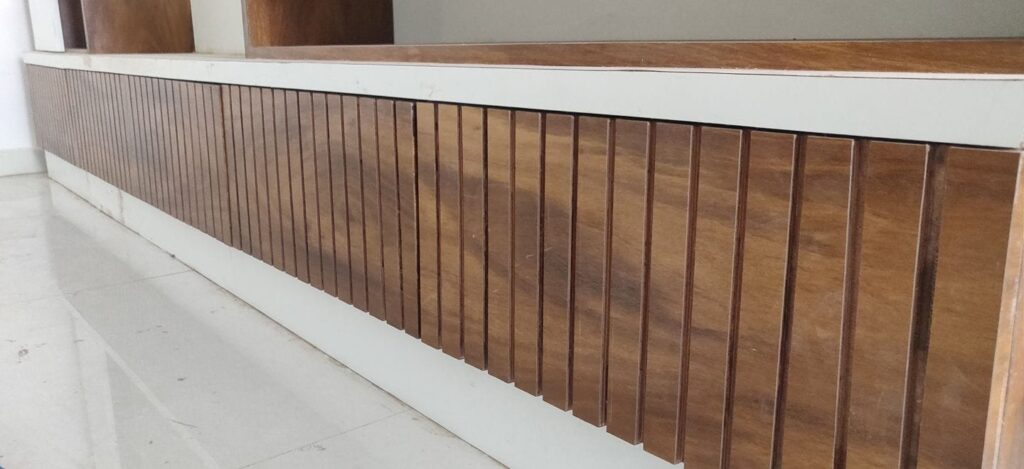
Designing the interior of a hall involves creating a welcoming and aesthetically pleasing space that aligns with your preferences and lifestyle. Here are some general tips and ideas for designing the interior of a hall:
Color Scheme:
Choose a color palette that reflects the mood you want to create. Lighter colors can make the space feel more open, while darker colors can add warmth and coziness.
Consider accent colors for furniture, accessories, or focal points.
Furniture:
Select furniture that fits the scale of the hall. Avoid overcrowding the space.
Consider a mix of seating options, such as sofas, chairs, and benches, to accommodate different preferences.
Opt for comfortable and stylish furniture that complements the overall design.
Layout:
Arrange furniture to create conversation areas or zones for different activities.
Pay attention to traffic flow, ensuring easy movement through the hall.
Consider the focal point of the room, such as a fireplace, large window, or a piece of artwork.
Lighting:
Use a combination of ambient, task, and accent lighting to create a well-lit and inviting atmosphere.
Consider statement light fixtures or chandeliers as focal points.
Ensure that natural light is utilized effectively, if available.
Flooring:
Choose flooring materials that are both stylish and practical. Options include hardwood, tiles, or rugs.
Use area rugs to define different zones within the hall and add texture or color.
Wall Decor:
Consider artwork, mirrors, or accent walls to add visual interest.
Wall-mounted shelves or display units can showcase decorative items or personal collections.
Window Treatments:
Select window coverings that enhance the overall design and provide privacy or light control as needed.
Curtains, blinds, or shades can contribute to the aesthetic of the hall.
Accessories:
Add personal touches through accessories like throw pillows, decorative vases, or sculptures.
Plants can bring life to the space and improve air quality.
Technology Integration:
Plan for the integration of technology, such as entertainment systems or smart home devices, while maintaining a clean and organized look.
Storage Solutions:
Incorporate stylish storage solutions to keep the hall clutter-free.
Consider multifunctional furniture with built-in storage.
Remember that the key to successful interior design is creating a space that reflects your personality and meets your functional needs. Experiment with different elements until you find a combination that suits your taste and lifestyle. Don’t hesitate to seek inspiration from design magazines, online resources, or consult with a professional interior designer for personalized advice.
Designing a TV unit and foyer are crucial aspects of the overall interior design for a home. Here are some ideas and tips for each:
TV Unit Design:
Wall-Mounted TV:
Consider mounting the TV on the wall for a clean and modern look.
Conceal cables using cable management solutions to maintain a tidy appearance.
Built-In Shelving:
Design built-in shelves or cabinets around the TV to create a cohesive and organized look.
Use a combination of open and closed storage for displaying decor items and hiding electronic components.
Accent Wall:
Create an accent wall behind the TV with a different color, texture, or pattern to make the TV area visually appealing.
Consider using materials like wood paneling or wallpaper for added interest.
Floating Shelves:
Install floating shelves to display decorative items, books, or personal artifacts.
Ensure proper spacing and alignment for a balanced look.
Hidden Storage:
Incorporate hidden storage compartments for items like DVDs, gaming consoles, or remote controls.
Use sliding panels or cabinets with doors to conceal electronics when not in use.
Lighting:
Add ambient lighting around the TV unit to enhance the viewing experience.
Consider LED strips, recessed lighting, or wall sconces for a subtle and stylish effect.
Personal Touch:
Decorate the shelves with a mix of family photos, artwork, and decorative objects.
Integrate elements that complement the overall theme of the room.
Foyer Design:
Entryway Furniture:
Choose practical and stylish entryway furniture such as a console table or a hall tree with hooks for coats and bags.
Add a stylish mirror above the console for a quick last-minute check before leaving.
Storage Solutions:
Incorporate storage baskets or bins beneath the console table to keep small items organized.
Consider a storage bench for additional seating and hidden storage for shoes or other items.
Lighting:
Install a statement light fixture or pendant to create a focal point in the foyer.
Ensure sufficient lighting for functionality, especially if the foyer lacks natural light.
Flooring:
Use a durable and visually appealing flooring material. Rugs or runners can add warmth and define the entry area.
Consider a stylish doormat for practicality.
Wall Decor:
Hang artwork or a gallery wall to add personality to the foyer.
Mirrors can also make the space feel larger and reflect light.
Functional Decor:
Place a decorative bowl or tray on the console for keys, mail, or other small items.
Incorporate a catch-all tray for items like sunglasses, wallets, or accessories.
Greenery:
Add potted plants or a vase of fresh flowers to bring life and freshness to the foyer.
Theme Continuity:
Ensure that the design elements in the foyer complement the overall interior design of the home.
By carefully planning and incorporating these design elements into the TV unit and foyer, you can create functional, visually appealing, and welcoming spaces in your home.




One thought on “A Comprehensive Guide to Designing the Perfect Hall Interior”
Comments are closed.